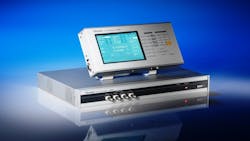10 MHz HF LCR Meter
Chroma Systems Solutions has added the Chroma 11050 HF LCR Meter precision test instrument to accurately measure and evaluate passive components at high speeds. Its measurement capabilities cover the primary and secondary parameters required for testing the inductance, capacitance, resistance, quality factor and loss factor of passive components. The HF LCR Meter has a broad testing frequency range from 1 kHz to 10 MHz suitable for analyzing the components’ characteristics under different frequencies and test levels from 10 mV to 5 V. Its 0.1% basic measurement accuracy provides stable and highly reliable results. A fast 15 ms measurement speed effectively increases productivity when working in an automated environment.
In addition to the excellent measurement features found in Chroma’s other LCR Meters, the 11050 includes additional useful functions. It has 3 output impedance modes to satisfy demands of measuring and working with other instruments. The versatile digital display can be configured to best fit the current testing resolution and the test signal monitoring function displays the voltage and current that is actually carried to the DUT. The timing settings of trigger delay, measure delay and average number of times allow the measurements to transfer seamlessly to an automated test environment providing accurate results within a limited testing time.
The Chroma 11050 adopts a detached design which provides several advantages. Since test processing and the display use separate CPUs, the testing speed is increased and shorter test leads are needed when integrated into an automated test environment. Shorter test leads improve the accuracy of high frequency measurements.
Chroma's 11050 HF LCR Meter has multiple remote interface options. Handler and RS-232C remote interfaces come standard for software or hardware control of test conditions, measurement trigger, judge test results, and collect measured data. The standard USB port saves device settings and controls the output of an external DC bias current source. Optional GPIB and Ethernet remote interfaces are available as well for software control.
